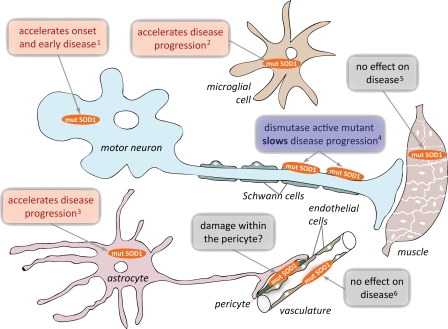Figure 2.
Contribution of mutant SOD1 within different cell types in ALS. Despite the apparent selectivity for motor neurons, multiple lines of evidence indicate that nonneuronal cell types contribute to pathogenesis and disease progression in SOD1-mediated neurodegeneration. Mutant SOD1 expression in motor neurons directs the onset and development of early disease, but does not influence its progression. In contrast, mutant SOD1 expression in microglia or astrocytes accelerates disease progression without affecting its onset. Expression of a dismutase-active mutant SOD1 specifically in Schwann cells was found to slow disease progression, but the role of a dismutase-inactive mutant in these cells has not been tested. Mutant SOD1 expression within muscle or endothelial cells does not affect ALS onset or progression, although some reports suggest that muscle might be a direct target of mutant SOD1 toxicity. Lastly, the vasculature is damaged very early in disease, leading to loss of tight junctions between endothelial cells and microhemorrhages, but whether any of this is from mutant SOD1 within pericytes, the terminal astrocyte, or coming from cells outside the vasculature is not established. 1(Ralph et al., 2005; Boillée et al., 2006; Jaarsma et al., 2008), 2(Beers et al., 2006; Boillée et al., 2006; Wang et al., 2009), 3(Yamanaka et al., 2008b), 4(Lobsiger et al., 2009), 5(Holzbaur et al., 2006; Miller et al., 2006; Dobrowolny et al., 2008; Towne et al., 2008), 6(Zhong et al., 2009).

